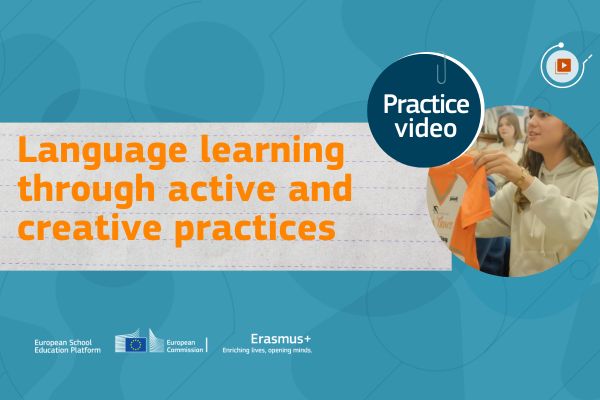Language learning through active and creative practices

Pilar Carilla, teacher
Personally, I am more and more convinced that traditional education does not work. We try to use patches like in a bicycle wheel – it doesn't work. You really have to dare. Not be afraid. Going out means seeing with the students what their needs are.
Lilou, student
Classes are on the Classroom platform; the teaching unit, the activities too. Every other day or so, the teacher shares interactive activities with conjugation games, vocabulary and so on. And we also do outdoor activities to practice things like outfits, clothes, the weather or stuff like that.
Camille, student
We play a lot of games and it allows us to learn while having fun.
Pilar Carilla, teacher
I really try to make sure that the language skills they learn in class are useful for real interactions with people, especially with young people of their age, at school, but also through travel, and also to surprise them and offer them real challenges. We call these challenges the final unit tasks. And in fact, they are evaluated based on their results, their challenges and the artistic installations they have had to present. We do a lot of Erasmus+ projects. It's a game-based approach. For me, it's very important that my students are motivated.
Deborah, student
I will tell you about the project “Jardineros y jardineras de la paz”. We went to Coria, Extremadura for a week and frankly, it was a lot easier to learn the language because we learned the language and traditions on the spot. And since we had a host family, we would talk with them. At first, it was a bit complicated to understand each other, but gradually it was much easier to communicate with them.
Kéandro, student
We did a lot of activities during this project, including the “Human Libraries.” In a room, there were people who came to tell us about an important moment in their lives which was related to peace, wellbeing, etc. and seemed important to them.
Camille, student
We took the time, about twenty minutes, to listen to them and to take notes. We were divided into groups of -students and sat around a table in a circle. Then, when they were gone, we chose a person whose story impressed us the most and we created this: it's a lapbook. As you can see, this is a three-dimensional book. Then, we explained the story we had understood.
Pilar Carilla, teacher
Something else that is very important, in my opinion, especially in secondary education, is that we must also prepare active and engaged citizens. We usually organise once a month, sometimes more often, a video conference with a nursing home in Zaragoza. And so, my students learn to speak Spanish practically by preparing activities to do with elderly people.
Nouhaila, teaching assistant
What I find the most significant about this new pedagogical approach is that it shows that the school or education of our dreams is possible through real interaction. For example, students don't have to study endless lists of grammar rules. They use the language in real-life situations.
Pilar Carilla, teacher
It's very important to encourage them every time they do something good. I always say that they need to be encouraged every time they take a step forward. Ultimately, we learn a language to interact with others, even if what we say is not perfect. And also, to understand the world of others, to open up to the world. So in the end, that's my main goal. Maybe not that my students write or speak perfectly, but that they want to talk, to communicate, and that what they say is heard by someone.
Additional information
-
Education type:School Education
-
Evidence:N/A
-
Funding source:European funding (Erasmus+)
-
Intervention level:N/A
-
Intervention intensity:N/A
-
Participating countries:Belgium
-
Target audience:TeacherStudent TeacherHead Teacher / PrincipalTeacher EducatorGovernment staff / policy makerParent / Guardian
-
Target audience ISCED:Lower secondary education (ISCED 2)Upper secondary education (ISCED 3)
